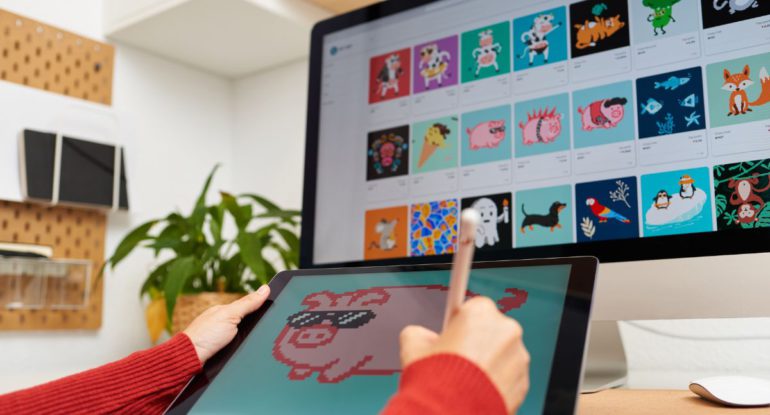How NFTs Are The Bridge Between Web2 And Web3

How are established businesses and platforms preparing for Web3? The transition from a time of social media and centralized databases to Web3, which values privacy and decentralization, makes it an intriguing subject. In the rapidly evolving landscape of digital innovation, Non-Fungible Tokens (NFTs) have emerged as a transformative force, acting as a bridge between Web2 and Web3. The transition from traditional, centralized web structures (Web2) to the decentralized and immersive experiences of the next generation (Web3) is marked by the unique capabilities and applications of NFTs. These digital assets, stored on blockchain technology, bring unparalleled ownership, authenticity, and interoperability, redefining the way we perceive, create, and exchange value in the digital realm. In this exploration, we will delve into how NFTs serve as a pivotal link, seamlessly connecting the familiar landscapes of today’s internet with the decentralized and limitless possibilities of the future.
The quick response? NFTs, or “non-fungible tokens,” are what they are employing.

Why is it crucial to comprehend NFTs? NFTs are considered to be digital assets that simulate actual items. These “objects” could be artwork, music, tickets, insurance policies, certifications, in-game goodies, and membership IDs; you get the idea. Use cases are expanding daily. You can demonstrate your legitimacy as contract owner or agreement owner by having an NFT.
Web3 stands for an open, 3D-immersive internet. In contrast to Web 2, dominated by centralized businesses owning, controlling, and monetizing users’ data in exchange for platform services like social media, search, or e-commerce, Web 3 will allow individuals to engage while maintaining full control over their data and how it is used. A new era of how people connect, communicate, work, and play is beginning thanks to Web3 applications built on the blockchain and improved by decentralized assets like NFTs. All of this is happening in an open, transparent environment.
Code-based non-fungible tokens (NFTs) have the potential to significantly contribute to a decentralized future. These digital assets are essential to a seamless, borderless world where access is made possible by smart contracts built into your NFTs. Consider using an avatar to represent yourself or your NFTs to automatically carry out transactions.
What role do metaverses play here? Consider them virtual, online settings that are currently mostly built in the cloud. Over time, NFTs will usher in new “Web3” ways of interacting and behaving as they develop creative ways to transport, own and transact with digital assets in these virtual environments.
NFTs as the web2 to web3’s connective tissue

The development of NFTs has ushered in a real-world link that makes it the ideal instrument to connect Web2 and Web3. Several well-known companies have launched tokenized versions of their real-world goods and solutions as part of their NFT experiments.
Metaverses like The Sandbox and Decentraland dominate the Web3 community with high-profile digital land sales and commercial alliances. They believe that the foundation of next-generation social networking will be NFT-based augmented experiences. Facebook has also increased its focus on its metaverse, even going so far as to rename the firm, Meta. Do you?
While launching community-based fan campaigns, major global entertainment and lifestyle companies like Tiffany & Co., Netflix, and Coca-Cola have linked NFTs and the Metaverse. Most of the time, NFTs act as test platforms to entice consumers and users to adopt Web3.
Here are some instances of how these companies use NFTs:

In November 2021, Nike opened Nikeland, a Metaverse storefront on the Roblox platform, to showcase their tokenized goods. RTFKT Studios, a producer of “next generation” NFT collectibles, is also owned by the company.
The third collection of limited-edition NFTs will be released as part of the US clothing company GAP’s ongoing NFT program, which was launched in January this year, according to the announcement of their most recent partnership, GapXDemit, made in June of this year.
Since last year, Coca-Cola has launched NFT collectibles, most recently 136 digital collectibles in celebration of Pride Month in partnership with South African fashion designer Rick Minsi, with all proceeds going to LGBTQIA+ organizations.
NFTs and metaverses already have close ties in blockchain gaming and other interoperable games, which serve as value carriers for major digital social media platforms.
NFTs are becoming important elements of metaverses and platforms that the general public might adopt. You may guess that Meta will spearhead the effort to make NFT capabilities available in most homes. However, they are not the only group with lofty goals for a metaverse.
Future ventures that aim to ride the Web3 wave will increase. Non-fungible tokens (NFTs) will be extensively used by 2022. The branding industry will change as NFTs become a Web3 to traditional company branding bridge. Such branding would entail conducting contests to win prizes and building a strong neighborhood to support the company. Now, users can use their favorite NFTs as their Twitter or Reddit profile pictures; Facebook and Instagram will follow soon after.
Also Read: NFTs And Web3: Understanding The Intersection Of Blockchain And Digital Art
NFTs are widely used in the metaverse.

NFTs have a far bigger and more important role in the Metaverse’s creative community. By allowing people to claim or transfer ownership of specific objects or even more abstract ideas like identity, NFTs make it possible for several essential Metaverse components to operate. NFTs allow several crucial Metaverse components to work, while cryptocurrencies act as fungible tokens and facilitate payments and the exchange of value across blockchains and the Metaverse. NFTs are essential for creating trustworthy communities and social environments because their features make them a permanent record of who owns what and make them impossible to steal or fraudulently replicate. Even as people enjoy the early benefits of virtual environments and the Metaverse’s promise during the pandemic or dream of a future where one can access one’s private imaginary world with everything imaginable at the touch of a finger, there are potential issues surrounding the Metaverse’s future.
Our society is already moving in the direction of the Metaverse. Although regulatory and governance laws around NFTs are still developing, they offer an exciting opportunity for creators and businesses. In the Web3 era, NFTs can be effectively leveraged to increase interaction, assist, and please customers.
Web3 platforms provide enormous promise for today’s artists as screen time rises with the worldwide population due to the expanding gig economy, remote work, and online education. Web3 technology will soon become much more intuitive and immersive, and we might even have to relearn the importance of close connections in the process.
GM
How did I start in Web3?
Well, my friend introduced me to web3. It has been more than a year now. He told me I could get a whitelist and flip NFTs to make some money. Well, that made me really happy as I was looking for ways to generate income for myself.
However, I was… pic.twitter.com/BdAvayFqLa
— Babycakes (@babycakes_eth) November 17, 2023
Conclusion
Non-Fungible Tokens (NFTs) have proven to be a revolutionary force in the transition from Web2 to Web3, offering a paradigm shift in the way we engage with digital content, ownership, and value. By providing a decentralized and secure framework for representing digital assets, NFTs empower creators and users alike, fostering a more transparent, accessible, and equitable digital ecosystem. The bridge between Web2 and Web3, constructed by NFTs, not only preserves the familiar aspects of the internet but also propels us into a future where decentralized, community-driven interactions, and the concept of true ownership redefine the possibilities of our online experiences. As we witness the continuous evolution of NFTs, their role as a transformative catalyst in shaping the future of the internet becomes increasingly evident, promising a more inclusive, interconnected, and innovative digital landscape for generations to come.
FAQs about NFT in Web3 world
Q: How is NFT related to Web3?
A: NFTs (Non-Fungible Tokens) are intrinsically related to Web3, as they represent unique digital assets secured on blockchain technology. In the context of Web3, NFTs enable decentralized ownership, traceability, and interoperability, aligning with the principles of a more open and user-centric internet.
Q: Is it possible to bridge an NFT?
A: While the term “bridging” is typically used in the context of connecting different blockchain networks, the concept of bridging an NFT can refer to ensuring interoperability between various platforms. Projects and protocols are emerging to facilitate cross-chain compatibility, allowing users to interact with and trade NFTs seamlessly across different blockchain ecosystems.
Q: How are NFTs linked to blockchain?
A: NFTs are closely linked to blockchain technology, which serves as the underlying infrastructure for their creation, storage, and verification. Each NFT is a unique token on a blockchain, providing a secure and transparent way to represent ownership and authenticity of digital assets. The use of blockchain ensures that the information about NFTs is decentralized, immutable, and tamper-proof.



























































